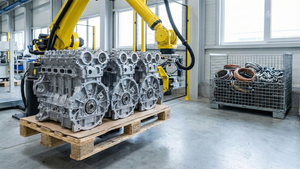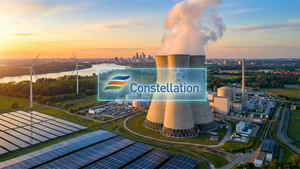> First-of-their-kind tests evaluated thermal treatment of AFFF fire fighting foam, PFAS-contaminated soil and spent carbon water treatment media
> Testing conducted based on EPA’s most current guidance for solids, liquids and stack air emission, including products of incomplete combustion (PICs) using the OTM-45 and OTM-50 methods
> Results demonstrated high temperature incineration is reliable and proven disposal solution for high concentrations of targeted PFAS, destroying greater than 99% of targeted substances, including up to 99.9999% of PFOS and PFHxS
Veolia has published the waste management industry’s most comprehensive testing to date on the incineration of PFAS compounds. The tests demonstrated that high temperature incineration is a proven and reliable disposal solution for high concentrations of targeted PFAS, destroying greater than 99% of targeted substances, including up to 99.9999% of PFOS and PFHxS.
PFAS contamination is a critical challenge due to its widespread presence and persistent nature. This testing, conducted using the EPA’s most current guidance, advances the scientific understanding of PFAS disposal and gives cities and industries more options for management of these compounds.
The two-phased study was conducted at Veolia’s hazardous waste incinerator in Port Arthur, Texas in July and October of 2024 by a third party provider. The facility was chosen based on its track record of managing PFAS-containing material, and its ability to reach a secondary combustion chamber temperature of 2,040 degrees Fahrenheit and a residence time of 2.3 seconds.
The testing evaluated thermal treatment of AFFF fire fighting foam, PFAS-contaminated soil and spent carbon water treatment media in alignment with the EPA’s most current guidance for solids, liquids and stack air emissions (EPA Interim Guidance on the Destruction and Disposal of PFAS - April 8, 2024). The testing used the OTM-45 and OTM-50 methods to evaluate products of incomplete combustion (PICs) in stack air emissions. The test results were recently announced at the 2025 PFAS Forum V in Tampa, Florida.
The key findings of the testing included:
- Overall result: High temperature incineration is an efficient disposal solution for high concentrations of targeted PFAS, destroying greater than 99% of targeted substances, including up to 99.9999% of PFOS and PFHxS.
- Solid residue: In 41 of 45 samples, there were no detectable quantities of the target PFAS in any of the ash, slag or filter cake. In four ash samples, target PFAS levels close to the method detection limit were identified.
- Liquid residue: Very low levels of the target PFAS were detected in liquid residues; the target PFAS residuals were below the method detection minimum, as well as the Maximum Contaminant Levels (MCLs) set by the EPA for drinking water.
- Air emissions: The destruction and removal efficiency (DRE) was greater than 99% for the majority of target PFAS, and few to no PICs were detected during incineration, indicating highly effective destruction.
“This testing demonstrated that high temperature incineration is a reliable and proven disposal solution for high concentrations of targeted PFAS. Veolia takes our role as industry leaders seriously, which is why we take a scientific approach in conducting the industry’s most comprehensive, modern and credible testing of PFAS incineration. As part of our GreenUp strategy, we have curated the industry’s only truly end-to-end solution for PFAS management: Beyond PFAS. This test is one more step in our journey to protect human health and the environment,” said Bob Cappadona, President and Chief Executive Officer of Veolia North America’s Environmental Solutions and Services business
Veolia provides drinking water to more than 9 million people across the United States and is in the forefront of the fight against PFAS. It has treated more than 24 billion gallons of water for PFAS at more than 30 sites, with dozens more under construction or in planning.
Veolia’s BeyondPFAS suite of offerings helps industries and businesses confronting the challenge of regulated PFAS compounds in their water supplies, work processes or waste streams. It streamlines Veolia’s offerings with a holistic approach from initial site assessment and sampling, to implementation of tailored treatment technologies, through proper handling and disposing of contaminants in line with current EPA-recommended methods such as incineration, deep well injection and secured, approved landfills.
As science and the public continue to learn more about PFAS compounds, Veolia’s BeyondPFAS offering will become a key part of the company’s strategy to bolster its leading role in addressing the world’s ecological problems. It also exemplifies the goals of Veolia’s global GreenUp strategy, which strives to lead the ecological transformation of the planet by accelerating water quality improvement, hazardous waste treatment and disposal, decarbonization and technological innovation.
ABOUT VEOLIA NORTH AMERICA
A subsidiary of Veolia group, Veolia North America (VNA) is the top-ranked environmental company in the United States for three consecutive years, and the country’s largest private water operator and technology provider as well as hazardous waste and pollution treatment leader. It offers a full spectrum of water, waste, and energy management services, including water and wastewater treatment, commercial and hazardous waste collection and disposal, energy consulting and resource recovery. VNA helps commercial, industrial, healthcare, higher education, and municipality customers throughout North America. Headquartered in Boston, Mass., Veolia North America has more than 10,000 employees working at more than 350 locations across the continent. www.veolianorthamerica.com
ABOUT VEOLIA GROUP
Veolia Group aims to become the benchmark company for ecological transformation. Present on five continents with 215,000 employees, the Group designs and deploys useful, practical solutions for the management of water, waste and energy that are contributing to a radical turnaround of the current situation. Through its three complementary activities, Veolia helps to develop access to resources, to preserve available resources and to renew them. In 2024, the Veolia group provided 111 million inhabitants with drinking water and 98 million with sanitation, produced 42 million megawatt hours of energy and treated 65 million tons of waste. Veolia Environnement (Paris Euronext: VIE) achieved consolidated revenue of 44.7 billion euros in 2024. www.veolia.com
DISCLAIMER
The information contained in this statement is based on the Veolia group's understanding and know-how of the scientific, regulatory and technical fields discussed herein as of the time of publication. No contractual undertaking or offer is made on the basis hereof and no representation or warranty is given as to the accuracy, completeness or suitability for the purpose of the relevant information. Descriptions contained herein apply exclusively to those examples and/or to the general situations specifically referenced, and in no event should they be considered to apply to specific scenarios without prior review and validation. Statements that may be interpreted as predictive of future outcomes or performance should not be considered guarantees of such, but rather reasoned assessments of the possible evolution of the technologies described.
No contractual undertaking or offer is made on the basis of this statement, any contractual commitment or relationship being subject to the conclusion of separately documented written agreement(s) between Veolia and its co-contractant(s).
View source version on businesswire.com: https://www.businesswire.com/news/home/20250509968132/en/
First-of-their-kind tests evaluated thermal treatment of AFFF fire fighting foam, PFAS-contaminated soil and spent carbon water treatment media
Contacts
VEOLIA NORTH AMERICA
Nate Pepper
Vice President, Communications
346-351-0024
nathan.pepper@veolia.com






